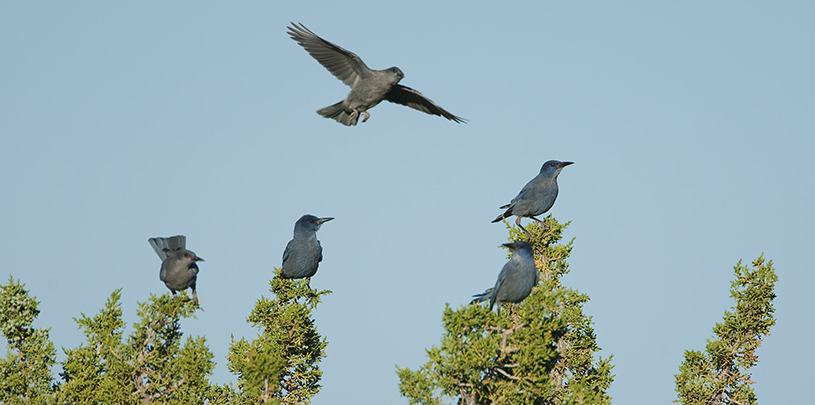
 by Audrey Kruse, Community Engagement Director
by Audrey Kruse, Community Engagement Director
Not too long ago (think back to the age of bell bottom pants and disco), pinyon jays used to soar throughout the pinyon and juniper forests of the Colorado Plateau in flocks of more than 200 birds. But in the last 50 years, pinyon jay populations across the West have decreased by an estimated 85 percent. Scientists expect the numbers to fall another 50 percent by 2036.
So what’s happening to pinyon jays? Researchers believe the key to their declining numbers is changes to their habitat, including a hotter and drier climate, and the intentional removal of pinyon and juniper trees by federal agencies that manage public lands.
We’re looking for volunteers to help gather information about pinyon jays to inform sound management of pinyon and juniper forests in Grand Staircase-Escalante and Bears Ears national monuments, and elsewhere throughout the Colorado Plateau. Will you join us? Birdwatch in the name of conservation. Sign up today ›
Pinyon jays and pinyon pines depend on one another for survival. The pine trees produce loads of hearty seeds every three to seven years and rely on the jays to disperse and bury (or cache) the seeds in the soil. The pinyon jays are savvy collectors and finders, caching tens of thousands of seeds each summer and fall and retrieving them over the winter and spring. The few forgotten seeds hold promise to become the next generation of pinyon pines.
Large, old pinyon pines serve as grocery stores and homesites for pinyon jays. Pinyon pines start to produce robust seed crops at 25-35 years, and they really hit their stride once they’re about 75 years old. Studies from New Mexico show that pinyon jays prefer to nest in large-canopied trees. When we advocate for forest protections, we emphasize the need to protect old-growth stands of pinyon pines.
Hotter temperatures and drier conditions across the Southwest and Colorado Plateau mean that pinyon pines produce fewer cones (and seeds) year after year, directly impacting the jays and other animals that rely on these seeds for food. Extreme drought has caused large-scale die-offs of pinyon and juniper trees across the Colorado Plateau in the last 20 years.
Pinyon jays have surprisingly complex behaviors and flock structure. They can live in flocks of 50-500, and the flock will often post a “sentinel” bird to keep a wary eye out for predators, like snakes, owls, hawks, and ravens. An expandable throat pouch allows the jays to temporarily store over 50 seeds, so they can transport them several miles away. A pinyon jay can cache 20,000 seeds in a single season and remembers about 95 percent of its hiding places. Could you remember where you put 19,000 keys?
Whenever you’re out hiking across the Colorado Plateau, and especially in Grand Staircase-Escalante and Bears Ears national monuments, you can help us look for pinyon jays. All you need is a smart phone and keen ears and eyes.
The data and observations you collect will help us advocate for protection of the birds and their pinyon-and-juniper forest homes. We’ve designed an easy-to-follow online training. After you complete it, you’ll be ready to head out with binoculars in search of pinyon jays. When and where you collect the data is up to you, but we ask that you look for jays four times throughout the year.
As 2024 draws to a close, we look back at five maps we created this year that give us hope for 2025.
Read MoreThe federal government will determine if the charismatic blue bird should be listed as threatened or endangered.
Read MoreWe can’t wait to meet you in a canyon, along a creek, or in the high alpine meadows of the Colorado Plateau.
Read More